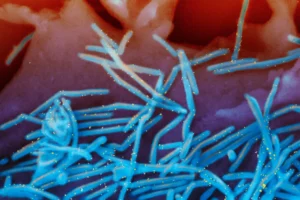Evidence Points to Women Hunting Big Game in the Early Americas, New Study Reveals
Research challenges ‘sweeping interpretation’ of men exclusively hunting large mammals
- Published In: Other News & Features
- Last Updated: Dec 05, 2023

Pictured above are flaked stone tools associated with the two individuals uncovered at the Wilamaya Patjxa burial site. Artifacts 1–7, 25, and 26 have been identified as projectile points. (Courtesy photo from the “Lithic usewear confirms the function of Wilamaya Patjxa projectile points” study)
By Shen Wu Tan
Special to the Wyoming Truth
Who says hunting is just a man’s sport?
Research of a 9,000-year-old burial site in Peru conducted by University of Wyoming (UW) and University of Louisville professors suggests otherwise, pointing to evidence that women joined in the hunts as well.
Archaeologists and Indigenous partners stumbled upon the Wilamaya Patjxa grave during a 2018 excavation in the Andes Mountains, where they uncovered an adult individual interred with a large-mammal hunting toolkit with seven projectile points.
The study’s findings, published in early November in the journal Scientific Reports, contradict the widespread theory that men primarily hunted big game in early human communities in the Americas thousands of years ago.
“Archaeological examples of large-mammal hunting are often argued to be exclusively associated with males, but our findings challenge this sweeping interpretation,” said Ashley Smallwood, the study’s author and a University of Louisville anthropology professor.
Smallwood specializes in lithic use wear analysis, a method for studying microscopic wear patterns on stone tools to determine their functions.
“We know based on the ethnographic record that there are social and ecological circumstances that favored female hunting in forager societies,” she added.
Initially, the researchers believed the interred individual at the burial site was a male hunter, but further analysis revealed it was actually female. They also found a male individual buried with two flaked stone artifacts at the site.
Smallwood and Randy Haas, a UW professor and archaeologist, conducted more research to confirm whether the projectile points found at the burial site were, indeed, projectile points. Thomas Jennings from the University of Louisville also contributed to the article.
For the study, Haas and Smallwood traveled to the Peruvian Andes, lugging a laser scanner and microscope, to further inspect the artifacts. They concluded some of the artifacts were projectile points, which exhibited signs of wear, including evidence of cutting and hide scraping “consistent with animal processing activities,” the study states.
A few pieces of evidence indicate hunting activities at Wilamaya Patjxa focused on big game, per the researchers’ article. The burial site contained a variety of burnt large-mammal bones, including deer and camelid. Also, Andean rock art depicts individuals hunting big game, and stone projectiles are commonly associated with large mammal remains and hunting features throughout the Americas.
“I am personally a big fan of this study,” Spencer Pelton, Wyoming state archaeologist, told the Wyoming Truth. “In my opinion, the Wilamaya Patjxa burials are among the most important ever discovered in the Americas and will continue to revolutionize our understanding of early Americans for years to come. The methods used to excavate this burial and establish these implements as weapons are solid.”
Pelton noted another archaeological example that suggests women in the Americas hunted: the 11,000-year-old “Gordan Creek Woman” who was uncovered in burials located south of Laramie in the Poudre River drainage. The woman was interred with what Haas and his research team described as hunting tools.
“So, these patterns of females associated with hunting implements are truly a hemisphere-wide phenomenon,” Pelton said.
Although the researchers theorize the individual was a female hunter, they acknowledged other possible explanations for the burial site. The first alternative interpretation could be that the artifacts were not projectile points, but knives used for domestic purposes. Another explanation could be that the objects served as symbolic offerings for community members to honor the deceased female or provide her with hunting tools for the afterlife.
“Use wear analysis was an approach that we took to evaluate competing hypotheses,” Haas said. “Different uses of stone tools leave distinct microscopic traces on their surfaces…. Ashley’s analysis showed definitively that the tools had been used as projectiles, supporting the interpretation that the individual used the tools to hunt large mammals.”
There are several socio-ecological conditions that would favor hunting by females, such as communal hunting of big game and closeness of large mammals to camp, according to the study.
“We hope this study inspires archaeologists to continue examining the socio-ecological circumstances of gendered labor divisions in forager societies,” Smallwood said.
The researchers have conducted a “second field season of investigation” and are applying different methodological strategies to reconstruct the diets of the individuals, Haas said. Additionally, they are examining DNA to better understand the origins of these early highland populations.













